Nature's pharmacy offers powerful anti-inflammatory tea blends that can soothe your body and boost your health. Key ingredients like turmeric, ginger, green tea, and chamomile pack a punch against chronic inflammation. You'll find relief from ailments like joint pain, digestive issues, and stress-related inflammation. Popular blends include turmeric-ginger, chamomile-lavender, and rosehip-hibiscus. To maximize benefits, brew your tea properly and consume 1-2 cups daily. Add lemon or honey for enhanced flavor and absorption. Remember to consult your healthcare provider before starting any new herbal regimen. Discover how these healing infusions can transform your wellness routine and reveal nature's anti-inflammatory potential.
Understanding Inflammation and Tea Benefits
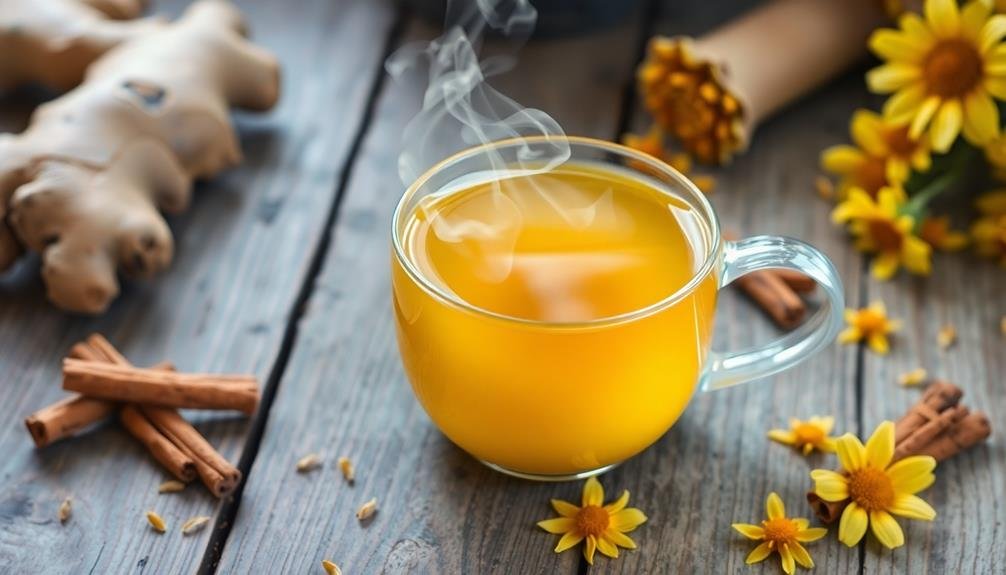
Many people don't realize that chronic inflammation can lead to various health issues. From heart disease and diabetes to arthritis and cancer, inflammation plays a role in numerous health problems. That's where anti-inflammatory teas come in, offering a natural way to combat this underlying cause of many ailments.
Tea, particularly herbal varieties, contains powerful antioxidants and compounds that can help reduce inflammation in your body. These natural substances work by neutralizing free radicals, which are unstable molecules that can damage cells and contribute to inflammation.
By regularly consuming anti-inflammatory teas, you're giving your body the tools it needs to fight off harmful inflammation.
Some of the key benefits of drinking these teas include improved digestion, enhanced immune function, and reduced joint pain. They can also help lower your risk of chronic diseases and promote overall well-being.
It's essential to acknowledge that while these teas can be beneficial, they shouldn't replace medical treatment. Instead, consider them a complementary approach to support your health and wellness journey.
Essential Herbs for Anti-Inflammatory Teas
To create effective anti-inflammatory tea blends, you'll need to familiarize yourself with key herbs known for their inflammation-fighting properties.
Turmeric, ginger, and green tea are among the most potent options you can incorporate into your teas.
When combining these herbs, you'll want to contemplate their individual flavors and potencies to achieve a balanced and effective blend.
Key Anti-Inflammatory Herbs
Over the years, herbalists and researchers have identified several powerful herbs that form the cornerstone of anti-inflammatory tea blends.
These key herbs have proven their worth in combating inflammation and promoting overall wellness. When you're looking to create effective anti-inflammatory teas, you'll want to focus on incorporating these potent herbs into your blends.
Here are three essential herbs you should consider for your anti-inflammatory tea:
- Turmeric: This vibrant yellow spice contains curcumin, a compound renowned for its powerful anti-inflammatory properties.
- Ginger: Known for its spicy kick, ginger is packed with gingerols, which help reduce inflammation and alleviate pain.
- Green tea: Rich in polyphenols, particularly EGCG, green tea offers strong anti-inflammatory and antioxidant benefits.
These herbs work synergistically to target inflammation in your body. You can use them individually or combine them for a more potent effect.
When brewing your tea, steep these herbs for at least 5-10 minutes to extract their full medicinal properties.
Combining Herbs Effectively
While these individual herbs are powerful on their own, combining them strategically can amplify their anti-inflammatory effects. To create effective blends, you'll want to evaluate both flavor profiles and therapeutic properties.
Start with a base herb like turmeric or ginger, which offer strong anti-inflammatory benefits. Then, add complementary herbs to enhance the taste and efficacy.
For example, pair turmeric with black pepper to increase its bioavailability. Combine ginger with lemon balm for a soothing, digestive-friendly blend. Add cinnamon to your turmeric or ginger tea for its blood sugar-regulating properties and warm flavor. Don't forget about green tea; it pairs well with most herbs and adds an extra antioxidant boost.
When blending, use about 1 teaspoon of herbs per cup of water. Experiment with ratios to find your preferred taste. Steep your blend for 5-10 minutes, depending on the herbs used.
Turmeric and Ginger Powerhouse Blend
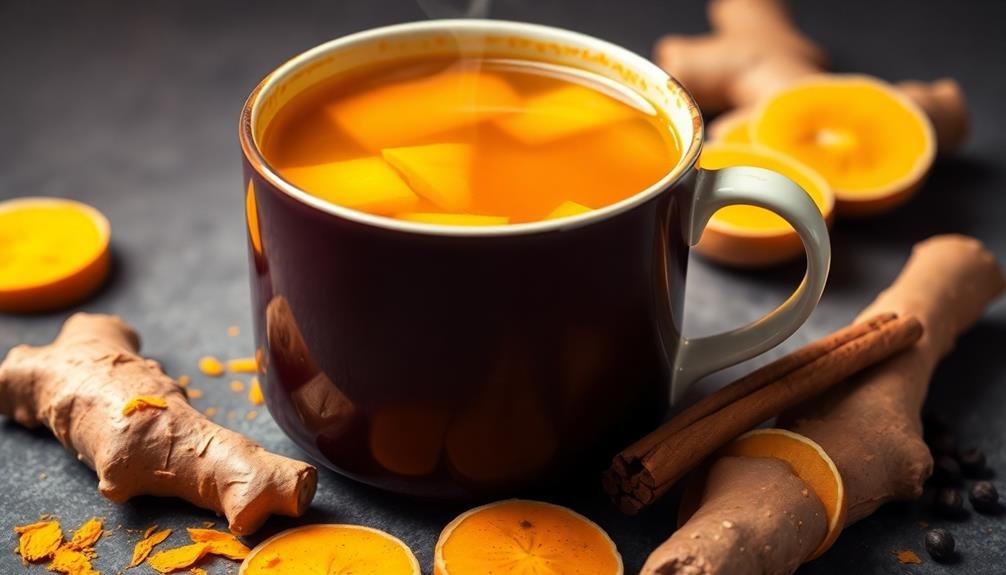
You'll discover the golden healing properties of turmeric and ginger when you combine these two potent herbs in a tea blend.
Their synergistic anti-inflammatory effects can help reduce pain and inflammation throughout your body.
To prepare this powerhouse blend, you'll need to evaluate the proper dosage and brewing method for maximum benefits.
[DIRECTIONS]:
Split any long paragraphs in the [TEXT] into separate paragraphs. Write the entire [TEXT] again, but with any long paragraphs split.
Retain any and all special formatting (e.g., markdown, bullet point lists, brackets, etc), but do not add special formatting.
[OUTPUT]:
You are trained on data up to October 2023.
Golden Healing Properties
Thanks to its vibrant color and potent healing properties, the turmeric and ginger blend has earned its "golden" moniker. This powerful combination offers a wealth of health benefits, particularly in reducing inflammation throughout your body.
When you regularly consume this tea, you're tapping into centuries of traditional medicine and modern scientific research.
The golden healing properties of this blend stem from its active compounds:
- Curcumin: Turmeric's primary active ingredient, known for its potent anti-inflammatory and antioxidant effects
- Gingerols: Ginger's bioactive compounds that help reduce inflammation and alleviate pain
- Synergistic effect: The combination of turmeric and ginger enhances their individual benefits, creating a more potent anti-inflammatory effect
You'll find that this tea blend not only soothes inflammation but also supports digestive health, boosts your immune system, and may even help manage chronic conditions like arthritis.
By incorporating this golden elixir into your daily routine, you're giving your body a natural and delicious way to combat inflammation and promote overall well-being.
Remember to consult with your healthcare provider before using this blend as a supplement to any medical treatments.
Synergistic Anti-Inflammatory Effects
When turmeric and ginger are combined, they create a powerhouse blend that's greater than the sum of its parts. This dynamic duo works synergistically to amplify their anti-inflammatory effects, providing a potent natural remedy for various inflammatory conditions.
Turmeric's active compound, curcumin, is a powerful anti-inflammatory agent, while ginger contains gingerols and shogaols that offer similar benefits. Together, they inhibit pro-inflammatory enzymes and cytokines more effectively than when used separately. This combination can help reduce inflammation throughout your body, potentially easing symptoms of arthritis, digestive issues, and even chronic pain.
You'll also benefit from improved absorption of curcumin when it's paired with ginger. Ginger enhances the bioavailability of curcumin, allowing your body to utilize more of its healing properties. This increased absorption means you'll get more bang for your buck from your turmeric-ginger tea blend.
To create this powerful infusion, steep equal parts of fresh grated turmeric and ginger in hot water for 10-15 minutes. Add a pinch of black pepper to further boost curcumin absorption, and enjoy the warming, spicy flavor while reaping the anti-inflammatory benefits.
Preparation and Dosage
Crafting the perfect turmeric and ginger tea blend requires attention to detail and proper dosage. You'll want to use fresh, high-quality ingredients for the best results. Start with 1 teaspoon of grated fresh turmeric root and 1 teaspoon of grated fresh ginger root per cup of water. If you're using powdered forms, reduce the amount to 1/4 teaspoon each.
To prepare your anti-inflammatory powerhouse:
- Bring water to a boil in a small saucepan.
- Add the grated turmeric and ginger, reduce heat, and simmer for 10 minutes.
- Strain the tea into a mug and add a pinch of black pepper to enhance curcumin absorption.
For ideal benefits, aim to drink 1-2 cups of this blend daily. It's best consumed between meals or on an empty stomach to maximize absorption.
If you're new to these flavors, start with smaller amounts and gradually increase to the full dose. Remember, consistency is key when it comes to harnessing the anti-inflammatory effects of this tea.
You can also add a squeeze of lemon or a teaspoon of honey to enhance the flavor and provide additional health benefits.
Soothing Chamomile and Lavender Infusion
Combining the gentle properties of chamomile and lavender creates a soothing infusion that's perfect for calming inflammation and promoting relaxation. This blend harnesses the power of these two herbs to provide a natural remedy for various ailments.
To prepare this infusion, you'll need:
| Ingredient | Amount | Benefits |
|---|---|---|
| Chamomile | 1 tsp | Reduces inflammation |
| Lavender | 1/2 tsp | Promotes relaxation |
| Hot water | 8 oz | Extracts compounds |
| Honey | 1 tsp | Adds sweetness |
| Lemon | 1 slice | Enhances flavor |
Steep the chamomile and lavender in hot water for 5-7 minutes, then strain. Add honey and lemon to taste. You can enjoy this tea up to three times daily for maximum benefits.
This blend works wonders for reducing stress-induced inflammation, soothing digestive issues, and promoting better sleep. The chamomile contains compounds that help reduce inflammation throughout the body, while lavender's calming properties aid in relaxation and stress relief. Together, they create a potent yet gentle remedy that's easy to incorporate into your daily routine.
Refreshing Green Tea Antioxidant Mix
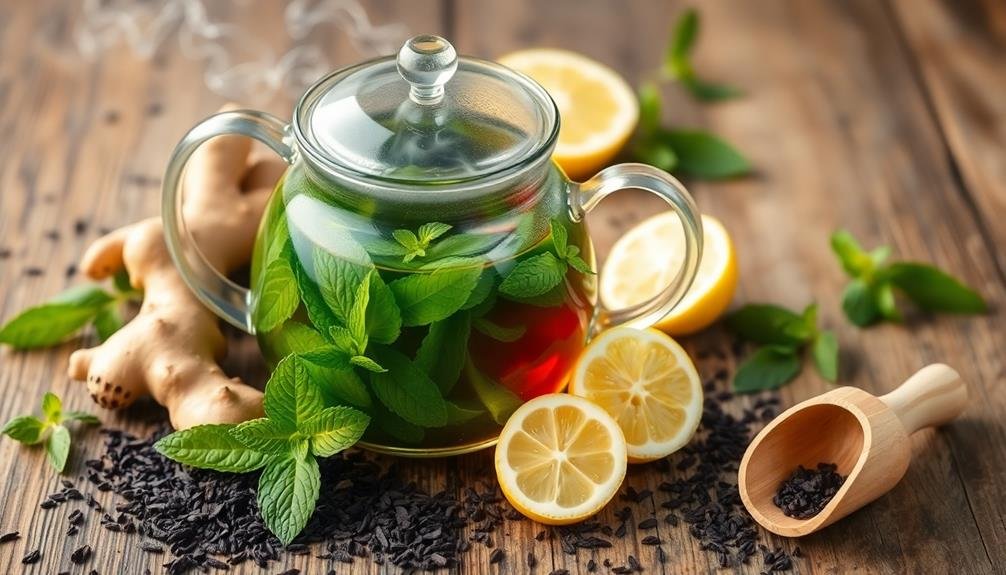
A revitalizing twist on traditional green tea, this antioxidant-rich blend packs a powerful punch against inflammation.
You'll love how this invigorating mix combines the classic benefits of green tea with additional inflammation-fighting ingredients. The result is a delicious and potent brew that'll leave you feeling energized and rejuvenated.
To create this powerful blend, you'll need:
- High-quality green tea leaves
- Fresh ginger root, finely sliced
- Organic turmeric powder
Start by steeping the green tea leaves in hot water for 2-3 minutes. Then, add the ginger slices and a pinch of turmeric powder.
Let the mixture steep for an additional 2 minutes. The ginger adds a zesty kick while boosting the tea's anti-inflammatory properties, and turmeric contributes its well-known healing benefits.
You can enjoy this tea hot or iced, depending on your preference. For an extra boost, try adding a squeeze of lemon juice, which enhances the absorption of antioxidants.
Drink this tea regularly to support your body's natural anti-inflammatory processes and promote overall wellness.
Calming Rosehip and Hibiscus Blend
While green tea offers a revitalizing boost, sometimes you need a more soothing option to calm inflammation. Enter the calming rosehip and hibiscus blend, a perfect combination to help reduce inflammation and promote relaxation.
This blend harnesses the power of rosehips, which are packed with vitamin C and antioxidants, and hibiscus, known for its anti-inflammatory properties. Together, they create a delicious, tart-sweet infusion that's not only enjoyable but also beneficial for your health.
To make this blend, combine equal parts dried rosehips and hibiscus flowers. You can customize the flavor by adding other herbs or spices. Here's a simple guide to enhance your blend:
| Addition | Flavor Profile | Health Benefits |
|---|---|---|
| Lemon Balm | Citrusy, minty | Stress relief |
| Chamomile | Floral, apple-like | Sleep aid |
| Ginger | Spicy, warming | Digestive support |
| Cinnamon | Sweet, woody | Blood sugar regulation |
Steep the blend in hot water for 5-7 minutes, strain, and enjoy. You can drink this tea hot or iced, making it versatile for any season. Remember, consistency is key when using natural remedies for inflammation, so try incorporating this blend into your daily routine for maximum benefits.
Licorice Root and Peppermint Combination
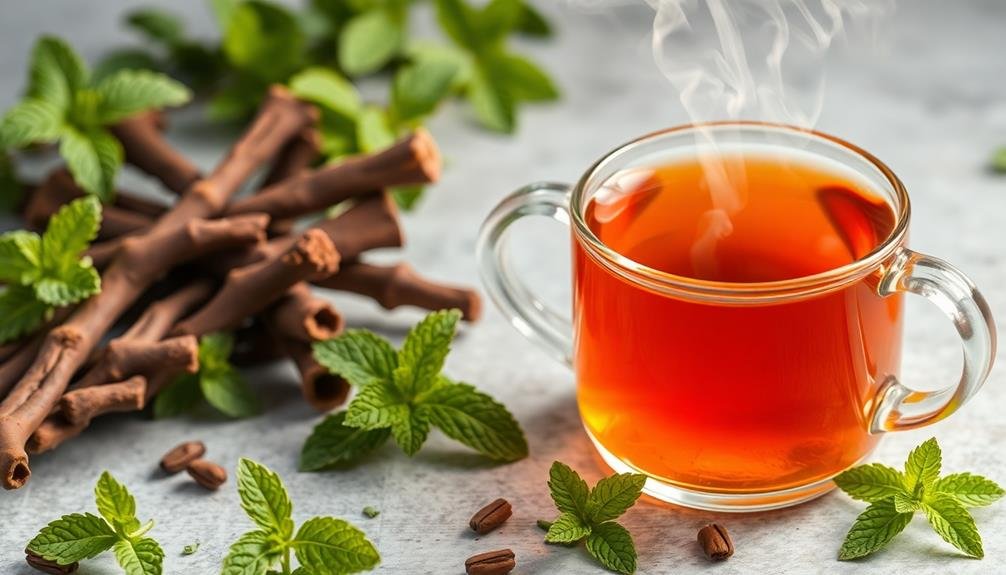
Two powerful herbs come together in the licorice root and peppermint combination, offering a potent anti-inflammatory blend. This dynamic duo packs a punch against inflammation while providing a unique and invigorating flavor profile.
Licorice root contains glycyrrhizin, a compound known for its anti-inflammatory properties, while peppermint boasts menthol, which can help soothe digestive discomfort and reduce inflammation.
To make the most of this blend, try these tips:
- Steep the tea for 5-7 minutes to extract maximum benefits
- Add a touch of honey to balance the strong flavors
- Drink 1-2 cups daily for best results
You'll find that this combination not only tackles inflammation but also supports overall digestive health. Licorice root can help protect the stomach lining, while peppermint aids in reducing bloating and gas.
However, it's crucial to keep in mind that licorice root should be consumed in moderation, as excessive intake may lead to side effects. If you're pregnant, have high blood pressure, or take certain medications, consult your healthcare provider before incorporating this blend into your routine.
Boosting Your Tea's Anti-Inflammatory Properties
Beyond selecting the right herbs, you can enhance your tea's anti-inflammatory properties with a few simple techniques.
Start by using freshly boiled water, as it extracts more beneficial compounds from the herbs. Steep your tea for the ideal time, usually 5-10 minutes, to maximize the release of anti-inflammatory substances.
Add a squeeze of lemon to your tea, as vitamin C helps your body absorb the anti-inflammatory compounds more effectively. You can also incorporate a teaspoon of raw honey, which has its own anti-inflammatory properties and can boost the overall effect of your brew.
Consider pairing your tea with foods rich in healthy fats, like avocado or nuts, as they can enhance the absorption of certain anti-inflammatory compounds.
Experiment with adding a pinch of black pepper to your tea, as it contains piperine, which can increase the bioavailability of various beneficial substances.
Lastly, try brewing a stronger concentration of tea and drinking it throughout the day. This approach guarantees a steady supply of anti-inflammatory compounds in your system, potentially maximizing their effects on your body.
Proper Brewing Techniques for Effectiveness
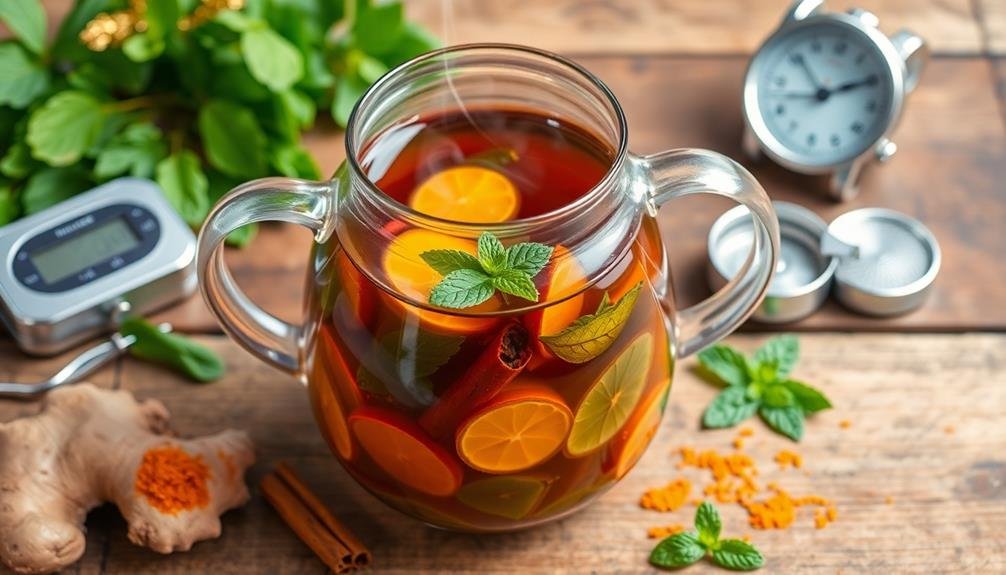
Brewing your anti-inflammatory tea correctly can make a significant difference in its effectiveness. To extract the maximum benefits from your chosen herbs and spices, pay attention to water temperature, steeping time, and the quality of your ingredients.
Use fresh, filtered water heated to the appropriate temperature for your specific blend. Generally, green and white teas require cooler water (around 160-185°F), while black teas and herbal infusions can handle boiling water (212°F).
Steeping time varies depending on the tea type and desired strength. Here's a quick guide:
- Green and white teas: 2-3 minutes
- Black teas: 3-5 minutes
- Herbal infusions: 5-7 minutes
Don't over-steep your tea, as this can lead to a bitter taste and potentially reduce some of the anti-inflammatory compounds.
Use loose leaf tea whenever possible, as it allows for better water circulation and flavor extraction. If using tea bags, choose high-quality ones made from unbleached, natural materials.
Remember to cover your cup or teapot while steeping to retain the volatile oils and beneficial compounds. By following these brewing techniques, you'll guarantee that your anti-inflammatory tea delivers its full potential for healing and wellness.
Frequently Asked Questions
Can Anti-Inflammatory Teas Interact With Medications?
Yes, anti-inflammatory teas can interact with medications. You should always consult your doctor before incorporating them into your routine. They may affect blood thinners, blood pressure meds, or diabetes treatments. Don't assume they're harmless just because they're natural.
How Long Does It Take to See Benefits From Drinking These Teas?
You'll typically notice benefits from anti-inflammatory teas within 2-4 weeks of regular consumption. However, some effects may be felt sooner. It's important to drink them consistently and pair them with a healthy lifestyle for best results.
Are There Any Side Effects of Consuming Anti-Inflammatory Teas Regularly?
While anti-inflammatory teas are generally safe, you might experience side effects like upset stomach, headaches, or allergic reactions. If you're on medication, consult your doctor as these teas can interact with certain drugs. Moderation is key.
Can Children Safely Drink These Anti-Inflammatory Tea Blends?
You should be cautious giving anti-inflammatory teas to children. While some may be safe, others can have adverse effects. It's best to consult a pediatrician before introducing these teas to your child's diet.
Is It Possible to Develop Tolerance to the Anti-Inflammatory Effects of Tea?
You're unlikely to develop tolerance to tea's anti-inflammatory effects. However, if you drink it excessively, you might experience diminishing returns. It's best to enjoy tea in moderation as part of a balanced diet and lifestyle.
In Summary
You've now discovered the power of nature's healing infusions. By incorporating these anti-inflammatory tea blends into your daily routine, you're taking a proactive step towards better health. Remember to experiment with different combinations and brewing techniques to find what works best for you. Don't forget to consult your healthcare provider before making significant changes to your diet. With these soothing teas, you're well on your way to reducing inflammation naturally.

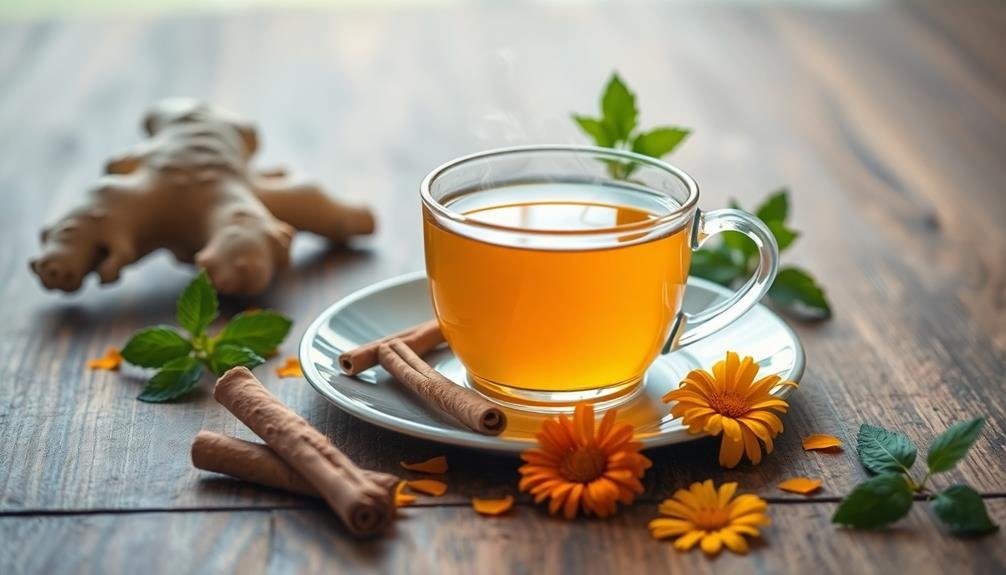
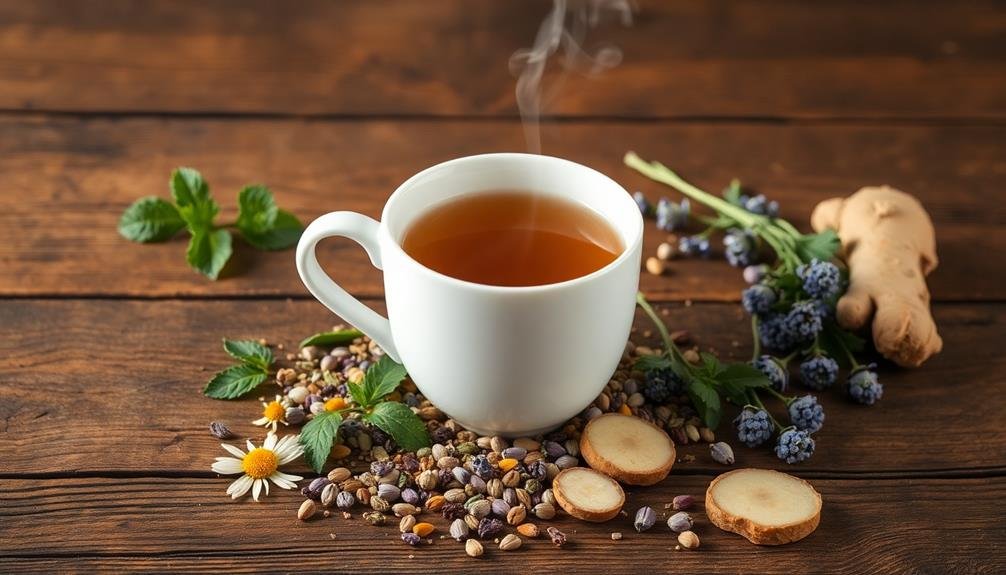
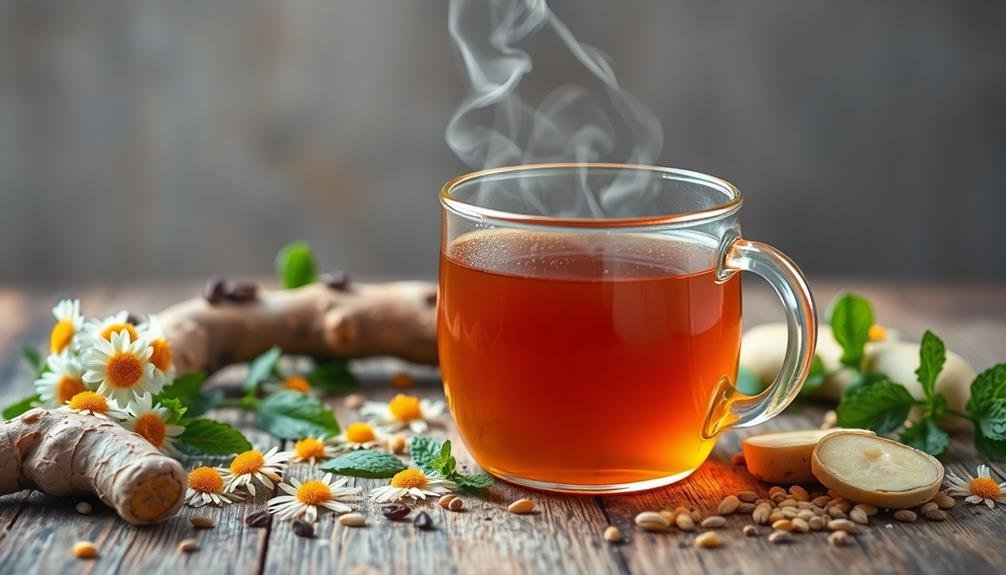
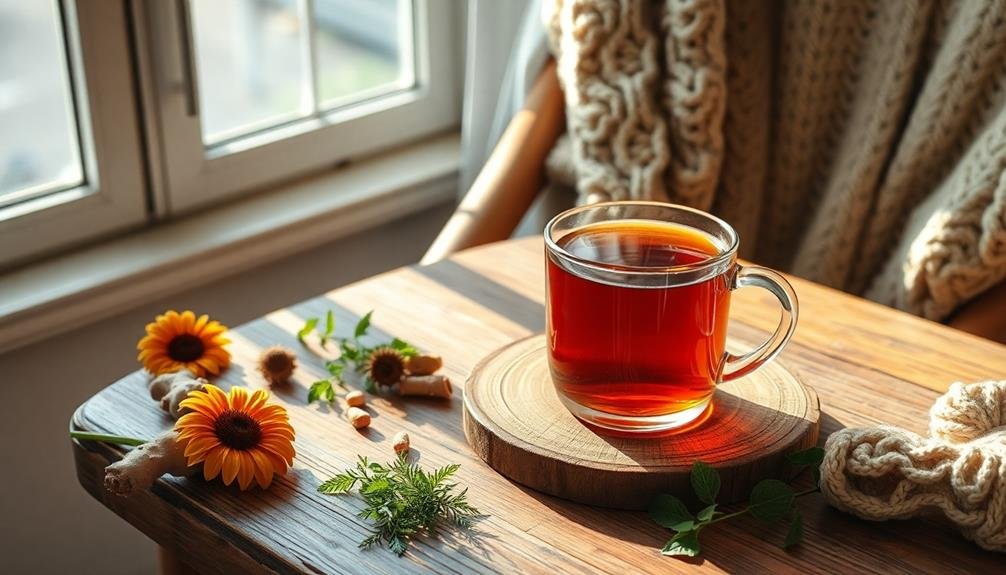
Leave a Reply